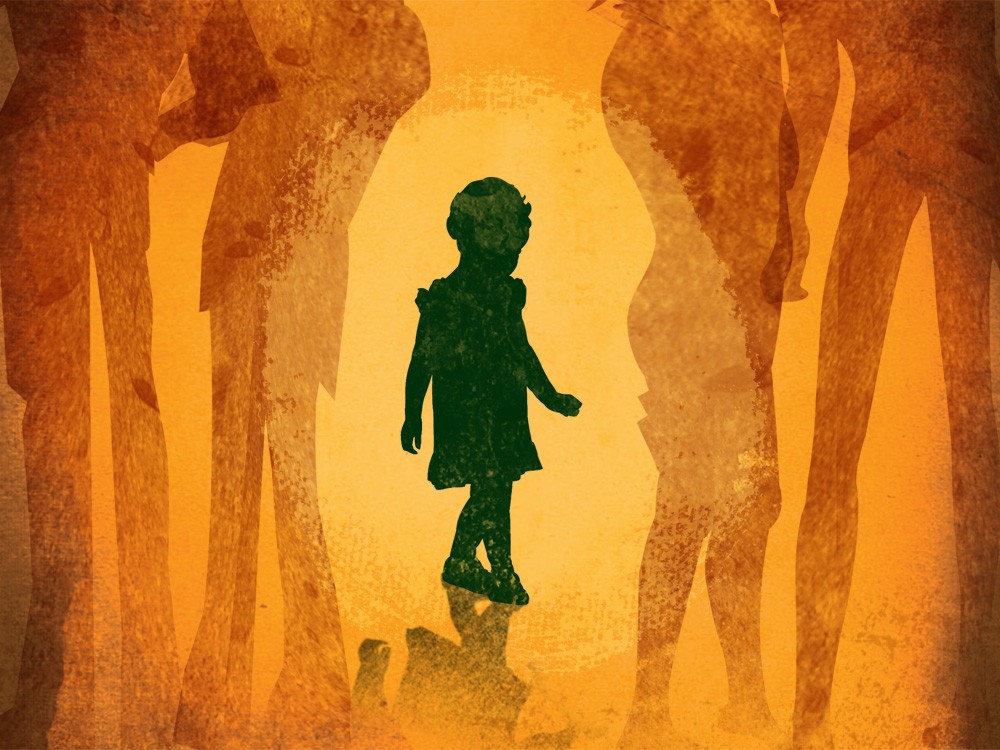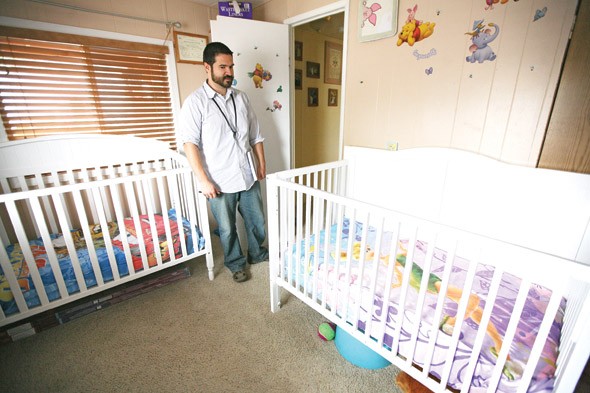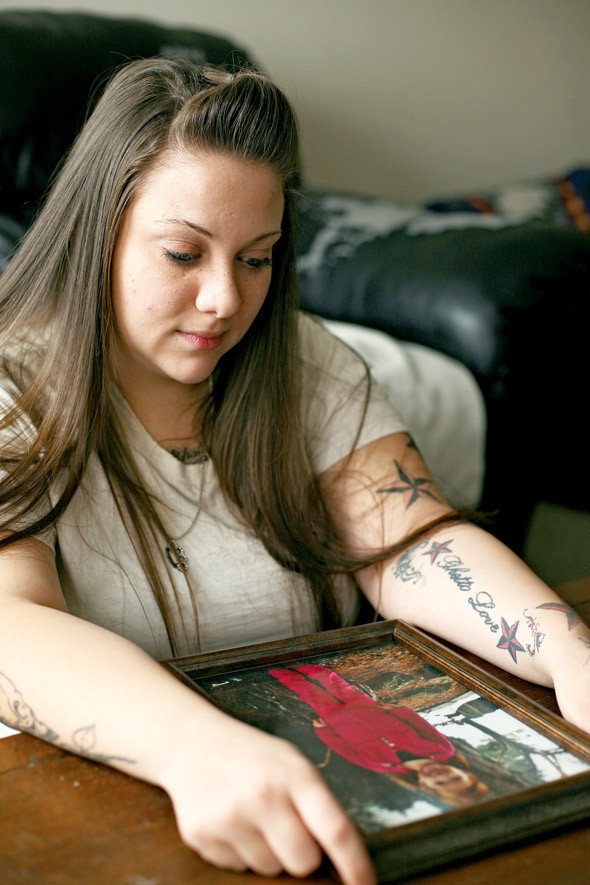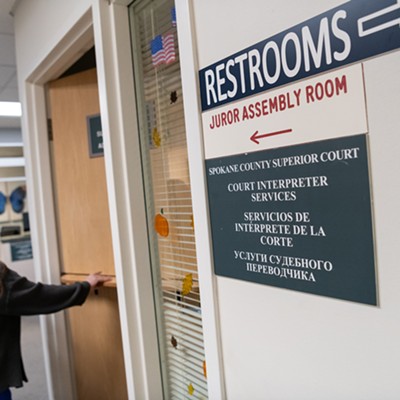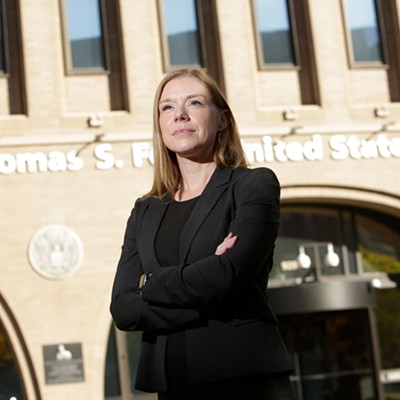When 16-year-old Amie Watkins first opened the door to her new foster home, she was immediately struck by the smell: urine. Six cats slinked through the mess, over dirt-stained carpets. Pots, pans and rotting food filled the sink. Green fuzz grew on old pizza.
Watkins lay sleepless on the twin bed in her new bedroom, on a sagging black-splotched mattress.
“It stunk and it was gross and it was cold and I didn’t want to be there. And I had to be there and I was forced to be there,” Watkins recalls. “It was heart-wrenching.”
Watkins photographed the filth for her caseworker. In three months, she was removed from the home and sent to another.
As a foster kid, she knew the cycle. Ever since she told her Head Start teacher she’d been sexually abused by her father, she had bounced between dozens of different people’s homes.
“I didn’t even really know what to become, what religion to take,” says Watkins, now 29. “I had to adapt to their habitat.”
Year later, some memories blur together. The homes in Kennewick, Spokane, Moses Lake, Glenwood, Fairfax. There was the lesbian couple, the Catholics, the Baptists. But she still remembers the foster father who tried to touch her in the hot tub. She remembers the bare walls and locked doors of a group home. She remembers the foster mother who punished her for pouring too much ketchup over a hot dog — forcing her to eat only ketchup for a week.
Foster care was supposed to protect Watkins from abuse and neglect, but it only led to more. She was shuffled through more than 25 homes.
Her case wasn’t unique. By the time Jessica Braam, another Washington state foster child, was 12, she’d been placed in 34 different facilities.
In 1998, Watkins and Braam joined 11 other foster care children to sue Washington state. It took six years, but that lawsuit created the Braam Oversight Panel, a committee tasked with reforming foster care in the state.
Slowly, Washington made notable strides in protecting the 9,000 children under its care.
But now, even as the system seems to be improving, overloaded child-welfare workers, a burdened foster-parent network, deeper budget cuts and dramatic restructuring threaten to erode those gains.
“It could mean the absolute destruction of any progress that’s been made,” says Casey Trupin, who worked on the Braam v. State of Washington class-action lawsuit. “It could set Braam back 10 years.”
Two Steps Forward
National data paint a grim picture of foster care. According to Casey Family Programs, a quarter of former foster children have post-traumatic stress disorder, and half have chronic medical problems. Other studies have found that nearly half of girls in foster care became pregnant by 19, and that fewer than 3 percent of former foster care kids in Washington and Oregon have earned a bachelor’s degree.
But it’s not an isolated issue. Earlier this month, a Post Falls couple was arrested in connection with the 2009 death of 2-year-old Karina Moore, who died of head injuries while in their foster home. Karina’s biological mother has filed a lawsuit against the foster parents, two state employees and the Idaho Department of Health and Welfare for being “reckless and negligent.” The foster parents blame the state of Idaho, saying they’d contacted the state for help with Moore’s medical conditions but never got any.
These were the sorts of problems that attorney Casey Trupin found when he started working on the Braam case. He’d worked with the homeless for years, but here, he thought, was an opportunity to help people before they landed on the streets.
“We can either pull the babies out of the bottom of the river or go up the river and see who’s throwing them in,” Trupin says.
The Braam Oversight Panel, formed in 2004 as part of the settlement, outlined 33 benchmarks the state must meet. Among them: fewer kids bounced between multiple homes, fewer unsafe placements, and fewer siblings separated. The state also must provide foster parents more training and support, offer kids better education and mental health services, and cut the caseloads of social workers.
Improvements came slowly, and in 2008, Trupin took the Children’s Administration back to court. The next year, Denise Revels Robinson, a 40-year veteran of child welfare work, became assistant secretary of the state’s Children’s Administration (part of the Department of Social and Health Services), and the culture changed.
“We started reviewing situations that involved children,” Robinson says. “We wanted to strengthen our focus on safety.”
Every time something went wrong with a child’s case, she required the local staff to convene immediately, asking what went wrong.
“We were saying, ‘Hallelujah,’” Trupin says.
Meanwhile, the Children’s Administration continued its philosophical shift: helping families before the kids landed in foster care, and focusing on quickly finding permanent homes for those currently in the system. Adoptions spiked — growing 36 percent a year, from 1,100 to 1,500 — and the average number of foster children declined.
Social workers’ caseloads also decreased. More children were screened for mental or drug problems. And though only about half of foster children receive a visit from their caseworker every month of the year, that rate is five times better than two years ago.
“The difference between now and four years ago is night and day,” Trupin says. At the end of last month, the Braam settlement was extended, giving the Children’s Administration two extra years to hit a scaled-down list of benchmarks outlined by the Braam panel.
Yet, around the same time, Gov. Chris Gregoire presented a budget proposal consisting of all cuts. It calls for cutting about $38 million from the Children’s Administration — an amount that advocates and caseworkers say could be disastrous.
One Step Back?
Courtney Canova hid under a desk in her second-grade classroom at Indian Trail Elementary School. She didn’t want to go home. Home wasn’t home.
She’d been taken from her parents — why, she didn’t know — and placed with an overweight old lady who wore a different wig every day. At that house, Canova says, she and the other foster kids were fed only Top Ramen noodles. The biological children got steak and mashed potatoes.
“It was just so dark,” Canova recalls. “You walk in and it was dark and unwelcoming, like they didn’t want you there.”
Canova, now 17, has joined the Mockingbird Society, an advocacy group that lobbies on behalf of foster kids. At a meeting in Spokane last month, Canova had a chance to ask Revels Robison about the looming budget situation. With a microphone in hand, Canova pressed for answers.
“Hi, my name’s Courtney. I’m a foster youth with the Mockingbird Society. And how are these budget cuts going to affect foster youth directly?”
She says Revels Robinson told her the cuts shouldn’t affect them at all. Revels Robinson says she meant the impact would be “minimal” — an assessment she stands by even after the governor released her “all cuts” budget recommendations.
Canova doesn’t buy it. “She lied to my face,” she says.
To the Mockingbird Society’s director, Jim Theofelis, the impact would be far from minimal. “There’s no doubt in my mind, an ‘all cuts’ budget will reverse any progress that we’ve made,” he says.
Gregoire’s proposed $38 million in cuts would raise social workers’ caseloads, eliminate several child-welfare programs and axe the educational coordinators trying to stop foster kids from dropping out. The shrunken budget would reduce placements to group homes, payments to child-placement agencies, and recruitment funds for adoptive parents. (Lawmakers return to Olympia this month and face an estimated $2 billion budget shortfall.)
In the current proposal, state funding for Sally’s House, representing about 70 percent of its budget, would be cut in half in January and then would be eliminated entirely by mid-year. Sally’s House, run by the Salvation Army, gives social workers an emergency location to place children in Spokane. Children stay for a few hours or up to 90 days while their caseworkers search for an ideal, stable home, without a major change in schools or locations.
Captain Kyle Smith, the military-dressed Salvation Army boss who has graying hair and a New Zealand accent, learned of the proposed cuts about a month ago.
Without Sally’s House, Smith worries, children would bounce between foster homes more often — exactly the problem that spurred the Braam case.
“It was a shock,” Smith says. “Kids in traumatic situations are going to be far more traumatized.”
Social workers would be forced to take up the slack, hurriedly calling around for available temporary foster homes. “If they were unable to bring them to Sally’s House,” says program manager Becky Hoogstad, “literally, children will have to sit in the back of patrol cars or the social workers’ cars for hours on end.”
And these days, social workers don’t have much extra time.
The Workload
The mobile home in Spokane Valley crackles with frenzied children. A little girl watches Blue’s Clues, and a curly-haired little boy runs his Hot Wheels car up and down the mother’s leg. The boy isn’t hers. Not yet.
Jon Pemberton, a bearded 30-year-old caseworker, sits on a couch, explaining that, after recent developments in the case, the woman will probably have the chance to adopt.
For Pemberton, this visit is a positive one: a child taken from a bad situation and adopted into a good home. But at his office, a government complex off Division Street, Pemberton says morale is worse than ever.
“When I first started, and the money was flowing freely, it was not uncommon for us to pay rent for our clients,” Pemberton says. That’s not the case anymore. Clerical support has been cut, and there are fewer work-study students. Training is done online, instead of in-person. They no longer have staff parties or barbecues. And with no money to pay agencies to transport children, social workers have to drive kids to visit their biological parents, sometimes an hour each way.
Social work, dealing with failing families, abused kids and troubled teens, has always been a profession that grinds up young idealists.
“The statistic I always hear is the life of a social worker is 12-24 months,” Pemberton says. “I can tell you from my experience from five years here … I’ve seen a few hundred in and out in here.”
Lately the economy has slowed turnover, Pemberton says, but it hasn’t reduced the workload. He’s got 60 hours’ worth of work and 40 hours to do it, and overtime isn’t available. If it’s not an emergency, he’s not allowed in the building after work hours.
And for all the improvements the Braam suit catalyzed, it’s given social workers more social work. They’re required to visit foster kids every month and document visits immediately.
Even though social workers are required to return foster kids’ telephone calls within 24 hours, they often don’t return them for days or weeks, according to several foster kids interviewed.
“I get calls from other people saying, ‘Hey, my social worker’s voicemail’s full,’” Pemberton says.
In response to the Braam lawsuit, caseloads were reduced. According to state data, they shrunk from an average of 24 cases per person to 18. For a while, the caseloads were protected from budget cuts. But lately Pemberton’s seen them creep back up. One of Pemberton’s colleagues tells him he’s juggling 33.
“The attention I’d like to give to certain cases, I cannot,” Pemberton says. “There’s a child I’m currently needing to locate … but I do not have the time to search for that child [thoroughly].”
And if the governor’s budget passes, caseloads will stack even higher, in direct violation of Braam guidelines. “We could go back to court,” Trupin says.
It’s a dilemma for the state Legislature. Rep. Kevin Parker, R-Spokane, says he’s met with foster kids — heard their stories of unreturned phone calls, of dismal graduation rates, of kids being placed in homes with rat feces. Of all proposed cuts, Parker says caseloads shouldn’t increase. It would damage the bond, he says, between caseworker and foster child.
Jessica Newberg used to be a foster kid. Across her upper chest, the tattooed words “This Too Shall Pass” speak about her experience in foster care.
“They just nonchalantly pass you along to another social worker. They don’t understand that we want structure,” says Newberg, now 20. “We don’t like being passed around like a toy.”
Stand-In Parents
The toddler was discovered during a drug bust and brought to Danielle Kemp’s home in Spokane. The girl’s little feet were black — dirt was crusted between her toes and under her fingernails. Her mismatched clothes reeked of cigarette smoke, urine and cat feces.
“It was putrid. We couldn’t keep [the girl’s clothes] in our home it smelled so bad,” Kemp says. The girl’s matted brown hair — after three weeks of washing — still smelled like cigarette smoke.
Kemp believes the girl hadn’t been fed well, if at all. When Kemp fed her, the girl would keep food in her cheeks — as if she didn’t know when she’d eat next. Kemp would have adopted her. But a month later, after positive court testimony for the parent, Kemp says the parent regained custody.
“You put on a happy face for the child, you kiss them on the top of their head,” Kemp says. “You love them. You turn back. And you break down in tears.”
In addition to normal parenting challenges, foster parents are asked to love a child — knowing that they’ll probably lose her.
“I would love to see the state become more child-centered, instead of parent-centered,” Kemp says. “They spend so much money on parents who are so broken. Some of them are beyond rehabilitation.”
The Kemps may soon quit foster care. While they praise most of the social workers they’ve encountered, they recently clashed with one. Now they’re in an exhausting tangle with the state — accused, they say, of being too involved with their foster children’s biological parents. They’re worried the state will retaliate against them for expressing their frustrations.
Revels Robinson, the assistant secretary of the Children’s Administration, says they shouldn’t worry: Retaliation from the department is not acceptable. Yet the Kemps’ complaints underscore the lack of trust sometimes felt between some foster parents and the state.
“With this last case, it took me eight phone calls to get a phone call back,” Kemp says. She blames the heavy caseloads. “How are they going to do a good job when they’re asked to do so much? How can they? They’re doing the best job they can with too much on their plates.”
Funding for group homes has also been cut, so more kids with behavioral problems end up in foster homes. At the same time, the number of kids with behavioral problems is rising, as services for them face deeper cuts.
“We’re almost traumatizing the adults who take care of traumatized kids,” says Theofelis, the Mockingbird Society’s director.
The number of children in the system has declined, but Washington still has far more foster kids than homes, which means many foster parents have to take two or three kids. And the number of available homes — whether due to more adoptions or frustration among foster parents — appears to be decreasing. Statewide, there were 331 fewer foster homes this September compared to last.
Mary McGauhey, answering the phone for the Foster Parent Association of Washington, attributes most of the exodus to frustration. For example, foster parents are supposed to get 48 hours of respite — essentially, babysitting for their foster kids by other foster parents — every month. But many don’t.
In one case, Pemberton says, a foster parent had two foster kids for nine months without a break, and she simply wanted a weekend off. “It took three weeks to get her a break,” Pemberton says.
Recently, Pemberton had to place two siblings a 90-minute drive away from their parents in Spokane. “There was not a single foster home in Spokane that had the availability to take two siblings,” he says.
What's Next?
There’s another reason, Pemberton says, that morale’s so low among his colleagues. They fear for their jobs. Change is coming.
In 2009, legislators passed a bill that could dramatically change the way foster care is run. Currently, social workers contract with scores of different private agencies to provide care for foster kids. In the first phase, the new law would hold those contracts to performance standards, and the contracts would be consolidated under a few designated private agency.
In the second phase, two offices in the state would transfer half of all child-welfare cases to private agencies; it’s an experiment to see if Washington could privatize parts of the system, as other states have done.
Spokane is rumored to be one of the test locations, says Pemberton, whose colleagues are worried about losing their jobs.
Agencies like Children’s Home Society believe they can manage contracts better than the state. But others foresee disaster. The Washington State Employees Union represents child-welfare workers and predicts the reform would cost millions of dollars for implementation alone.
The union challenged parts of the new law, and the reform has been tied up in the courts for now.
As an example of a troubled, privatized system, the union points to Wisconsin’s Milwaukee County, which contracts with private agencies to manage foster care cases. In a period of four years, the local newspaper found, 22 children died despite clear warning signs that the children were in danger.
“[Some were] beaten to death and tortured for months, even as child-welfare workers had visited their homes monthly,” says Crocker Stephenson, an investigative reporter with the Milwaukee Journal Sentinel. “The unaccountability was astounding.”
The leader of the Milwaukee Children’s Bureau back then? Denise Revels Robinson. “She was an obstructionist,” Stephenson says. “She was afraid of scrutiny. She was very, very difficult to hold accountable.”
Revels Robinson says she hasn’t seen the Sentinel’s article, but she sees success in Milwaukee’s model. “We had more children staying at home safely, shortened length of stays,” she says. “We had children getting to permanency sooner. An increased focus on quality and accountability.”
McGauhey, of the Foster Parents Association, predicts catastrophe: “Everything you knew in the old system is now obsolete — except the problems,” McGauhey says. “The department will be in chaos.”
The debate has further strained the four-way relationship between social workers, foster parents, private agencies and the Children’s Administration.
In May, Pemberton found a slip of paper on his chair. It was a ballot from the union, asking him to vote “no confidence” in Revels Robinson’s leadership. Every employee in the bargaining unit got one. Pemberton didn’t mail his in; he thought that, in some areas, Robinson has done well.
But nearly 40 percent of the ballots came back — with 98 percent voting “no confidence.” The ensuing letter cited deep demoralization, miscommunication, crushing workloads and concern about “about the accuracy and completeness of information provided by Ms. Revels Robinson to legislators, the Braam Panel and the public.”
Revels Robinson attributes the complaints against her to worries over job security. But that, too, has an impact.
“In general,” Pemberton says, “it creates a sense of fear that permeates the office.”
Stable Ground
For Amie Watkins, now 29, it’s been years since she’s been in foster care — since the group homes, the abuse and the lawsuits.
Despite needing special education help early in her career, she graduated high school with a 3.9 GPA. She’s been married, she’s been divorced, and she’s now a stay-at-home mother, with two blond, cheery children of her own. Zackary is 8, Trevor is 6.
“The two boys I have are very important,” Watkins says. “I could make a difference and break the cycle of what happened to me when I was little.”
Sometimes, she says, she goes overboard, buying them things, snuggling with them and showing them affection. She wants to give them the stability, the consistency and the love that neither her parents nor the state of Washington gave her. As a mother, she’s increasingly aware of the gaps in her childhood.
“I was in so many different homes, which required different religions, different schools, different friends, and different social activities,” Watkins says. “I lost really what the whole of parenting was about.”
Looking ahead, Watkins wants to practice family law and work with foster youth. She hopes the requirements established by the Braam case stay in place beyond the 2013 deadline. All kids, she says, need to have equal opportunity.
In the meantime, she lives in her own house, bought in part by money she got as part of the settlement against the state.
“I just want to be in a stable environment,” she says. “I don’t want to be moving around.”

